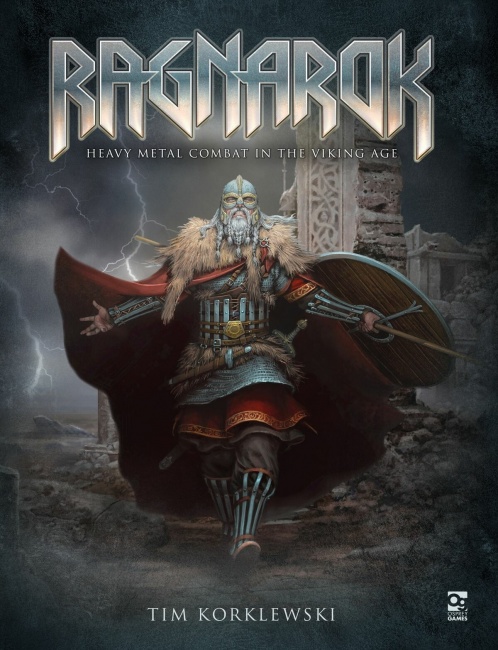Publisher: Osprey Games
Designers: Tim Korklewski
Illustration: RU-MOR
Release Date: May 30, 2019
MSRP: $35.00
Number of Players: 2 or more
Playing Time: 30 minutes or more
Age Rating: None given
Product #: 9781472832818 (UPC)
ICv2 Rating: 3 Stars out of 5
Tim Korklewski has leveraged his experience designing content for a variety of miniatures games (Malifaux 2.0, Dark Age, and Wrath of Kings, among others) to create the Morpheus Engine, intended as a core rules set that can be used for virtually any genre of miniatures game. The first appearance of the Morpheus Engine will be Osprey’s Ragnarok: Heavy Metal Combat in the Viking Age.
Summary: Ragnarok takes inspiration from the Norse legends, but heads in its own direction: Nidhoggr, a terrible dragon imprisoned in the roots of the World Tree Yggdrasil gnawed its way to freedom, causing the great tree to collapse. In its fall, the nine realms smashed together, killing the mighty Aesir gods and rupturing the barriers between the realms. All manner of ghastly and monstrous creatures could now invade Midgard, home of mankind, and the survivors must fight for survival in the ruptured world. Fortunately for them, the essence of the Aesir, called “Godspark” was released upon their death, and worthy mortals can gather it to perform miraculous feats. If they can gather enough, they can become gods themselves.
Mechanically, Ragnarok eschews the “I-go-you-go” system in favor of one where players alternate activating one model at a time and can even interrupt an opponent’s actions by triggering a “clash.” When activated, a model has a number of action points, that can be spent freely to move, attack, or perform special activities in any order and combination they wish. Most actions are resolved using two six-sided dice, and almost all actions generate Godspark. Godspark is collected over time, and can be spent by members of the player’s “War Clan” to power their magical effects. The system also offers a wide variety of special attack effects, allowing players to force combatants to move, freeze or ignite them, or manipulate their attributes.
The game is intended not for single one-off battles, but as a campaign of battles using the same War Clans. This forces players to be more cautious about risking their warriors in an all-out bid for victory, and allows players to build up their strength (and god-like abilities) as the campaign extends over time.
Originality: There is a trend towards miniatures games that are designed for campaign play, which Ragnarok joins nicely. This style promises to reward players for more sensible tactics while still giving players incentive to press for victory. The cost to play is low, as players need only a handful of miniatures and three dice to play. The philosophy behind the Morpheus Engine is also interesting: If it lives up to its promise, players will be able to shift easily from genre to genre.
Presentation: The rules are in a 208-page, full-color, hardcover book, slightly larger than digest size, illustrated and manufactured with the high level of quality that one expects from Osprey. It has numerous images of nicely-painted models and excellent artwork to invoke the setting. I thought the cover was a bit on the dark side, and could be more attention-grabbing, but the logo is clear and easily readable.
Quality: The physical book itself is quite good—typical Osprey quality. Overall, the rules are clear and well-written, but many concepts could have been explained better and would have benefited from illustrated examples, which are mostly non-existent. It was apparently written with experienced miniaturists in mind, as it does not explain basic concepts like what “base to base” means or how to properly move miniatures. There’s nothing wrong with that per se, but it seems to me that a book that introduces a new multi-genre core system would have benefited from a lower bar to entry.
Marketability: Vikings continue to be popular right now, as they seem to be periodically, and there aren’t many alternatives for Norse-themed fantasy miniatures games, so I can easily imagine that Ragnarok will attract some attention, especially if the Morpheus Engine takes off and spawns additional games. The campaign element promises to keep players involved over an extended period, and judging by other miniatures games from Osprey, I expect that Ragnarok will be supported with scenario books and sourcebooks moving forward.
Overall: Ragnarok has a lot of intriguing ideas behind it. Gameplay feels more engaging than some miniatures games thanks to the single-model activation and the ability to react to your opponent’s actions. There is not a lot of downtime, and you’re part of the activity almost all the time. I also appreciate the campaign element, which I think promotes more balanced and “realistic” decision making on the part of a commander, who at least has to try to consider the well-being of their troops if they hope to keep up the fight, rather than the victory-at-all-costs philosophy that takes over with a one-off battle.
On the other hand, I wish that the rules set and the book was more accessible. Miniatures are a vibrant hobby at the moment, and Ragnarok has an unusual theme that could attract new players, but I fear the book may leave them more confused than engaged. But perhaps that was Korklewski’s intent: to offer a more nuanced experience for the cultured palate of veteran miniaturists, something for the no-longer-novice to graduate into. If so, it’s a solid offering with a lot of “sandbox” opportunities and a rich mythology to draw from and explore. And that’s why I’m giving this game 3 out of 5.




